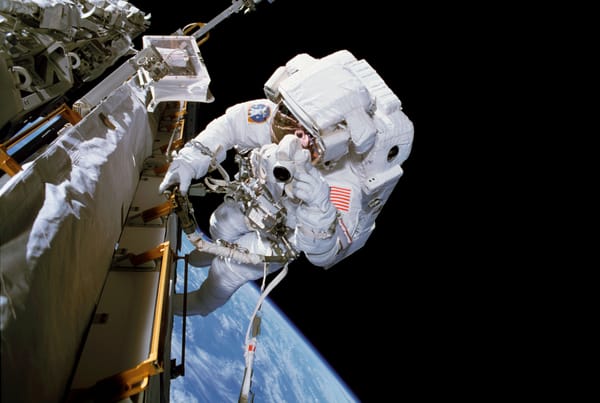The significance of Cassini's end
Many generations of physicists, astronomers and astrobiologists are going to be fascinated by Saturn because of Cassini.
I wrote this on The Wire on September 15. I lied. Truth is, I don’t care about Saturn. In fact, I’m fascinated with Cassini because of Saturn. We all are. Without Cassini, Saturn wouldn’t have been what it is in our shared imagination of the planet as well as the part of the Solar System it inhabits. At the same time, without Saturn, Cassini wouldn’t have been what it is in our shared imagination of what a space probe is and how much they mean to us. This is significant.
The aspects of Cassini’s end that are relevant in this context are:
- The abruptness
- The spectacle
Both together have made Cassini unforgettable (at least for a year or so) and its end a notable part of our thoughts on Saturn. We usually don’t remember probes, their instruments and interplanetary manoeuvres during ongoing missions because we are appreciably more captivated by the images and other data the probe is beaming back to Earth. In other words, the human experience of space is mediated by machines, but when a mission is underway, we don’t engage with information about the machine and/or what it’s doing as much as we do with what it has discovered/rediscovered, together with the terms of humankind’s engagement with that information.
This is particularly true of the Hubble Space Telescope, whose images constantly expand our vision of the cosmos while very few of us know how the telescope actually achieves what it does.
From a piece I wrote on The Wire in July 2015:
[Hubble’s] impressive suite of five instruments, highly polished mirrors and advanced housing all enable it to see the universe in visible-to-ultraviolet light in exquisite detail. Its opaque engineering is inaccessible to most but this gap in public knowledge has been compensated many times over by the richness of its observations. In a sense, we no longer concern ourselves with how the telescope works because we have drunk our fill with what it has seen of the universe for us…
Cassini broke this mould by – in its finish – reminding us that it exists. And the abruptness of the mission’s end contributed to this. In contrast, consider the story of the Mars Phoenix lander. NASA launched Phoenix (August 2007 to May 2010) in August 2007. It helped us understand Mars’s north polar region and the distribution of water ice on the planet. Its landing manoeuvre also helped NASA scientists validate the landing gear and techniques for future missions. However, the mission’s last date has a bit of uncertainty. Phoenix’s last proper signal was sent in November 2, 2008. It was declared not on the same day but a week later, when attempts reestablish contact with Phoenix failed. But the official declaration of ‘mission end’ came only in May 2010, when a NASA satellite’s attempts to reestablish contact failed.
Is it easier to deal with the death of someone because their death came suddenly? Does it matter if their body was found or not? For Phoenix, we have a ‘body’ (a hunk of metal lying dormant near the Martian north pole); for Cassini, we don’t have a ‘body’. On the other hand, we don’t have a fixed date of ‘mission end’ for Phoenix but we do for Cassini, down to the last centisecond and which will be memorialised at NASA one way or another.
Spectacle exacerbates this tendency to memorialise by providing a vivid representation of ‘mission end’ that has been shared by millions of people. Axiomatically, a memorial for Cassini – wherever one emerges – will likely evoke the same memories and emotions in a larger number of people, and all of those people will be living existences made congruent by the shared cognisance and interpretation of the ‘Cassini event’.
However, Phoenix’s ‘mission end’ wasn’t spectacular. The lander – sitting in one place, immobile – slowly faded to nothing. Cassini burnt up over Saturn. Interestingly, both probes experienced similar ‘deaths’ (though I am loth to use that word) in one sense: neither probe knew the way an I/AI could that they were going to their deaths but both their instrument suites fought against failing systems all guns blazing. Cassini only got the memorial upper hand because it could actively reorient itself in space (akin to the arms on our bodies) and because it was in an environment it was not designed for at all.
The ultimate effect is for humans to remember Cassini more vividly than they would Phoenix, as well as associate a temporality with that remembrance. Phoenix was a sensor, the nicotine patch for a chain-smoking planet (‘smoking’ being the semantic variable here). Cassini moved around – 2 billion km’s worth – and also completed a complicated sequence of orbits around Saturn in three dimensions in 13 years. Cassini represents more agency, more risk, more of a life – and what better way to realise this anthropomorphisation than as a time-wise progression of events with a common purpose?
We remember Cassini by recalling not one moment in space or time but a sequence of them. That’s what establishes the perfect context for the probe’s identity as a quasi-person. That’s also what shatters the glaze of ignorance crenellated around the object, bringing it unto fixation from transience, unto visibility from the same invisibility that Hubble is currently languishing in.
Featured image credit: nasahqphoto/Flickr, CC BY-NC-ND 2.0.



